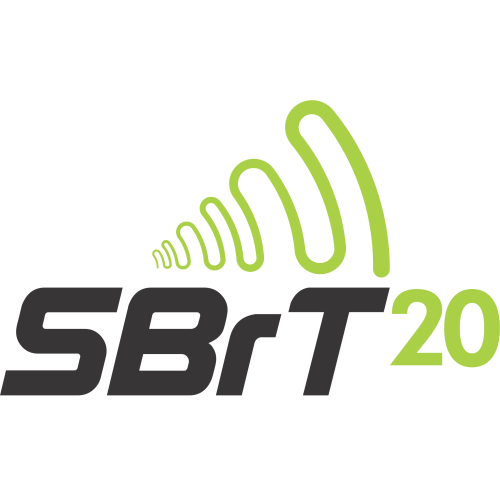
XXXVIII Simpósio Brasileiro de Telecomunicações e Processamento de Sinais
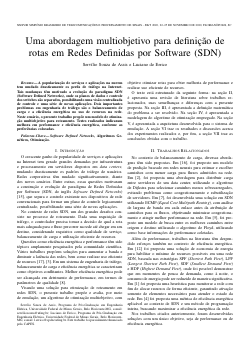
Uma abordagem multiobjetivo para definição de rotas em Redes Definidas por Software (SDN)
Servílio Souza Assis, Luciano de Errico
DOI: 10.14209/SBRT.2020.1570645099
Keywords: Software Defined Networks Genetic Algorithms Optimization
Abstract
The popularization of cloud services and applications has dramatically changed Internet traffic profiles. Such changes have instigated the evolution of the SDN (Software Defined Networks) paradigm, where the data plans and control of the switches are separated, allowing a centralized view of the control and a series of new applications. Two important problems in traffic engineering are load balancing and energy efficiency in the use of network resources. In this scenario, the present work proposes a multiobjective optimization model for routing. Performed tests indicated improvements in performance and energy efficiency, according to the preferences.Download
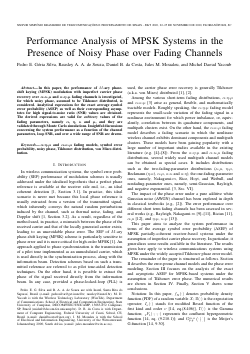
Performance Analysis of MPSK Systems in the Presence of Noisy Phase over Fading Channels
Pedro E Silva Gória, Rausley Adriano Amaral de Souza, Daniel Benevides da Costa, Jules M. Moualeu, Michel Daoud Yacoub
DOI: 10.14209/SBRT.2020.1570645370
Keywords: symbol error probability fading channels noisy phase Tikhonov distribution
Abstract
In this paper, the performance of M-ary phase shift keying (MPSK) modulation with imperfect carrier phase recovery over alpha-kappa-mu and alpha-eta-mu fading channels is investigated, for which noisy phase, assumed to be Tikhonov distributed, is considered. Analytical expressions for the exact average symbol error probability (ASEP) as well as their corresponding asymptotes for high signal-to-noise ratio (SNR) values are obtained. The derived expressions are valid for arbitrary values of the fading parameters, namely alpha, eta, kappa and mu, and they are validated through Monte Carlo simulations. Insightful discussions concerning the system performance as a function of the channel parameters, loop SNR, and over a wide range of SNR are drawn.Download
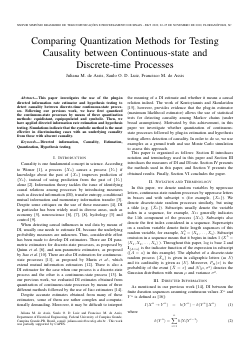
Comparing Quantization Methods for Testing Causality between Continuous-state Discrete-time Processes
Juliana M. de Assis, Saulo O. D. Luiz, Francisco M. de Assis
DOI: 10.14209/SBRT.2020.1570645510
Keywords: Directed information Causality Estimation Quantization
Abstract
This paper investigates the use of the plug-in directed information rate estimator and hypothesis testing to detect causality between discrete-time continuous-state processes. Following our previous work, we have first quantized the continuous-state processes by means of three quantization methods: equidistant, equipopulated and symbolic. Then, we have applied directed information rate estimation and hypothesis testing. Simulations indicate that the symbolic method is the most effective in discriminating cases with an underlying causality from those with abscent causality.Download
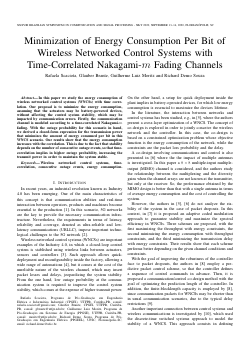
Minimization of Energy Consumption Per Bit of Wireless Networked Control Systems with Time-Correlated Nakagami-m Fading Channels
Rafaela Scaciota Simões da Silva, Glauber Brante, Guilherme Luiz Moritz, Richard Demo Souza
DOI: 10.14209/SBRT.2020.1570645612
Keywords: wireless networked control systems time-correlation consecutive outage events energy consumption
Abstract
In this paper we study the energy consumption of wireless networked control systems (WNCSs) with time correlation. Our proposal is to minimize the energy consumption, assuming that the actuators may be battery-powered devices, without affecting the control system stability, which may be impacted by communication errors. Firstly, the communication channel is modeled according to a time-correlated Nakagami-m fading. So, we obtained the outage probability in this scenario. With that in hand, we derived a closed-form expression for the transmission power that minimizes the amount of energy consumed per bit in this WNCS scenario. Our results show that the energy consumption increases with the correlation. This is due to the fact that stability depends on the number of consecutive outage events, so that time-correlation implies in higher outage probability, increasing the transmit power in order to maintain the system stable.Download
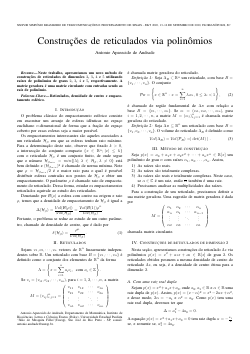
Construções de reticulados via polinômios
Antonio Aparecido de Andrade
DOI: 10.14209/SBRT.2020.1570645873
Keywords: Reticulados Densidade de centro Empacotamento esférico
Abstract
Neste trabalho, apresentamos construções de reticulados de dimensões 2, 3, 4 e 5 utilizando raízes de polinômios de graus 2, 3, 4 e 5, respectivamente, ou seja, mostramos que através das raízes de polinômios obtemos reticulados nas dimensões 2, 3, 4 e 5. Com esse processo podemos construir reticulados com densidade de centro ótima para qualquer dimensão.Download

Detecção da Doença de Alzheimer em Diferentes Estágios através do Espectro de Potências da Wavelet Packet de Sinais EEG
Rui da Cunha, Bruno C. Bispo, Pedro Miguel Rodrigues
DOI: 10.14209/SBRT.2020.1570645949
Keywords: Doença de Alzheimer EEG espectro de potência sub-banda,
Abstract
Este trabalho tem como objetivo detectar a doença de Alzheimer em diferentes estágios através de sinais EEG. Potências relativas às frequências convencionais são obtidas dos valores máximo, mínimo e médio de estimativas do espectro de potências da Wavelet Packet. Para cada par de grupos de estudo e eletrodo, uma seleção dos parâmetros é realizada. Os parâmetros selecionados são utilizados como entrada para classificadores com validação cruzada leave-one-out. Precisões de classificação de 100% são obtidas, em pelo menos 1 eletrodo, para os 6 pares de grupos analisados, indicando as regiões no escalpe com maiores diferenças à medida que a doença progride. E precisões médias, incluindo todos os eletrodos, entre 81,3 e 91,4% são alcançadas.Download

Two-Stage Indoor Positioning using Deep Learning and RF Fingerprinting in WiFi Networks
Rafael Saraiva Campos, Lisandro Lovisolo
DOI: 10.14209/SBRT.2020.1570646073
Keywords: multifloor positioning deep learning RF fingerprinting correlation function
Abstract
This work addresses the problem of radio frequency machine learning-based indoor multifloor positioning, by proposing a two-stage localization scheme. On the first stage, a majority voting committee of Deep Neural Networks (DNN) identifies the floor where the mobile station (MS) is most likely located. On the second stage RF fingerprinting, also known as Database Correlation Method (DCM), provides an estimate of the MS location within the selected floor. In DCM, target RF fingerprints - measured by the MS to be localized - are compared with georeferenced RF fingerprints, previously stored in a correlation database (CDB). The performance of the proposed solution is experimentally evaluated using 40800 target fingerprints and a CDB with 816 reference fingerprints, containing Received Signal Strength (RSS) values of 115 WiFi 802.11b/g networks spanning 3 floors. The proposed two-stage scheme achieved floor identification accuracies ranging from 91 to 97%, and mean planar positioning errors from 1.4 down to 0.4 meters.Download
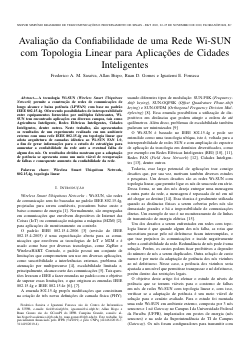
Avaliação da Confiabilidade de uma Rede Wi-Sun com Topologia Linear para Aplicações de Cidades Inteligentes
Frederico A M Saraiva, Allan Bispo, Ruan Gomes, Iguatemi E. Fonseca
DOI: 10.14209/SBRT.2020.1570646198
Keywords: Wi-Sun 802.15,4g topologia linear
Abstract
A tecnologia Wi-SUN (Wireless Smart UbiquituosNetwork) permite a construção de redes de comunicações de longo alcance e baixa potência (LPWAN) com base no padrão IEEE 802.15.4g. Oferecendo possibilidades de interoperabilidade entre equipamentos fornecidos por múltiplos fabricantes, Wi-SUN tem encontrado aplicações em diversos campos, tais como Agricultura Inteligente, Redes Elétricas Inteligentes, Cidades Inteligentes, dentre outros. Neste trabalho, mostramos os resultados de um experimento realizado em um ambiente externo com uma rede Wi-SUN em topologia linear, a fim de gerar informações para o estudo de formas de aumentar a confiabilidade da rede ante a eventual falha de algum dos nós. Os resultados obtidos mostram que a adaptação de potência se apresenta como um meio viável de recuperação de falhas e consequente aumento de confiabilidade da rede.Download

K-means clustering for mitigation of nonlinear phase noise in digital coherent optical systems using 16-QAM modulation format
Lucio Borges, Camila Costa, Rômulo de Paula, Marcelo Abbade, Ivan A Aldaya
DOI: 10.14209/SBRT.2020.1570646347
Keywords: Passive optical networks Nonlinear compensation Nonlinear phase noise K-means
Abstract
This work analyzes the use of the K-means clustering algorithm to mitigate nonlinear phase noise in single-span coherent systems, such as long-reach passive optical networks (LR-PONs). Simulations revealed that for a 100-km LRPON employing 16-ary quadrature amplitude modulation (QAM) and considering a 1:64 splitting ratio, the adoption of K-means with K-means++ initialization achieves an optimum bit error ratio (BER) of 6.310-4, whereas employing maximum likelihood, 10-3 is obtained. We also show that in order to achieve this performance improvement in 90% of the cases, K-means requires only 2,000 symbols.Download

Optimization of Element Positions in Linear Optical Phased Arrays for Broad Beam Steering Operation
Bruna Dias Pires de Souza, Ivan A Aldaya, Julián Pita, Marcelo Abbade, Paulo Jarschel, Rafael Abrantes Penchel
DOI: 10.14209/SBRT.2020.1570647134
Keywords: Photonic antennas Optical phased array Grating lobes LIDAR
Abstract
Optical phased arrays (OPA) are used to improve the radiation characteristics of single-element antennas and allow dynamic control of the radiation pattern. However, the manufacturing constrains of complementary metal oxide semiconductor (CMOS) platform limits the minimum inter-element separation to more than half of the operation wavelength, which in uniform arrays results in the appearance of high-intensity secondary lobes, called grating lobes. In this work, we optimize the position of the elements in a non-uniform linear OPA for different beam steering angles. The preliminary results showed that the optimal position of the elements depends on the desired beam steering angle.Download